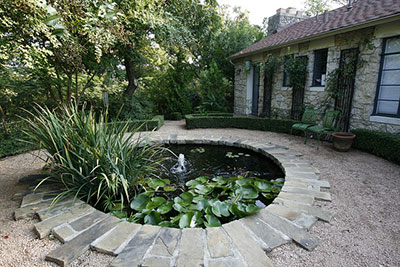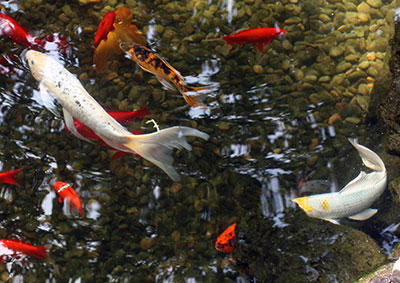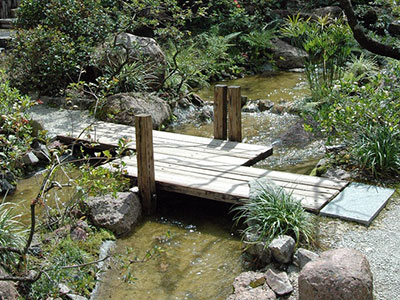Water Gardens
Take your landscaping to the next level by incorporating a water feature.

There are many kinds of water gardens, and each offers its own unique benefits and joys, such as the soothing sound of splashing water, the beauty of a water lily, and the flash of colorful goldfish or koi.
You can create a pond with materials easily found at most garden centers. Readily available rubber liners, pre-formed ponds, or large tubs make it easy to quickly create a water accent.
Allow your water garden to be a focal point by placing it where it will clearly be in view, such as next to your patio. The location should offer some shade to control algae growth, but still allow enough light for what you are growing. Filtered light or a mix of sun and shade is ideal.
There are many water plants that are simple to grow. Just make sure to choose ones that will thrive in the light conditions and size of your garden.
A water garden will provide you with many enjoyable sights and sounds, and it’ll be a water source for wildlife such as birds, frogs, and turtles.
Plants for Your Water Garden
It’s important to have a plan before you start buying plants for your water garden. Water garden plants are grouped based on how and where they grow, and they’re typically labeled as floating, submerged, or emergent. It’s a good idea to include a mix of all three.

Water lilies are floating plants that produce beautiful flowers in many colors. Their leaves shade the water and help reduce algal growth. You can choose either tropical or hardy varieties, depending on when you would like to see blooms.
Some water garden plants can also benefit wildlife. Yellow canna is a tall emergent plant that has bright yellow flowers that draw butterflies, and pickerel weed produces lavender, pink, or white flowers that attract bees.
There are plenty of native plants to fill the shoreline with as well. These include cardinal flower, duck potato, skyflower, lemon bacopa, two species of horsetail, American lotus, crinum lily, and several native species of water lilies.
For a submergent plant, try planting native fanwort or hornwort (also known as coontail). Both have feathery, whorled leaves, but fanwort is rooted while hornwort is free-floating.
Remember to choose the right-sized plants for your space and pick plants that cover no more than two-thirds of the water’s surface when mature.
Care and Maintenance
Just like having weeds in your lawn, you can also have weeds in your water garden. Algae are microscopic weeds that are sometimes a problem in water gardens. Left to grow unchecked, they can cause issues.

Since algae need sunlight in order to grow, you can curb their growth by choosing water garden plants that shade the water. Limit excess nutrients by fertilizing your water garden plants conservatively. Apply only what your plants need, and use slow-release nutrient tablets that can be pushed into the soil. Don’t overfeed or overstock fish, since both can disrupt the nutrient balance.
If your water garden is hosting an overabundance of algae, try adding more plants and rocks. These provide places for bacteria to colonize, and these bacteria help control algal growth. You can also directly add beneficial bacteria to your system to boost it. Try tossing barley balls into your water garden to further suppress algae growth. Both beneficial bacteria and barley balls can be found at specialty fish stores and online.
As a last resort, you can try an aquatic algicide. Always read the label and make sure the product is suitable for use around other plants and fish.
Mosquitoes
Mosquitos are not only a biting nuisance; they can carry many dangerous diseases. Mosquitoes can easily reproduce in standing water, so gardeners who have water gardens should take steps to keep these pesky insects in check.
If you have a small container garden, just add water to the container until it flows over the top and flushes out the mosquito larvae. Installing a pump in a larger water garden will circulate the water and make it less attractive to mosquitoes.
Another option is to add fish. Gambusia are small, native fish that feed on mosquito larvae and pupae at the water’s surface.
You can also buy mosquito dunks. These donut-shaped products gradually release the bacterium BT I (Bacillus thuringiensis israelensis) that kills mosquito larvae but is safe for plants, pets, and the environment.
Overwintering Water Gardens
Even though Florida’s winters are relatively warm, you still need to make special provisions for your water garden in the winter.
Many plants begin to go dormant as weather cools, so stop fertilizing them around this time if you are applying any. Don’t worry about cleaning out your pond until February or March because frogs and snails need to burrow in the pond’s organic matter to survive the winter. This annual cleaning should happen at the end of winter to also avoid disrupting the bacterial cycle.
Your fish will find the warmest parts of the water and spend the winter there. You can feed them less frequently than you did in the summer. With a little effort, you’ll ensure your garden will spring back to life with warm weather!
Fish Ponds
Ornamental ponds are a beautiful addition to any garden, and they’re only enhanced by the introduction of fish. Fish need room to swim, so the pond should be at least 500 gallons. Your pond will need a pump to move the water and keep it aerated. Aquatic plants will also provide oxygen, shade on hot days, and places to hide from predators. Introduce fish only once the plants have started to grow.
Purchase koi, inexpensive goldfish, or other fish suitable for an outdoor habitat from an aquarium or pet store. You can also adopt “rescues” from other koi enthusiasts in your community! Pools become mini aquatic environments and will attract visitors like dragonflies and frogs. To support all this life, your pond will need at least six hours of sun a day.
Koi
The word koi means “carp” in Japanese; modern-day koi have been selectively bred for centuries to add color and interest to water features. Koi come in many colors, and are either solid or patterned.

Koi are hardy fish, and easy to raise. They should have a pond with a depth of at least three feet. They eat a variety of foods, including peas and watermelon, or fish food purchased at a pet store.
Koi can live a long time, although their coloring makes them especially vulnerable to predators. To keep them safe from raccoons and birds, make your pond deeper in the middle and provide overhanging rock ledges so they have places to hide.
They do require a certain temperature water, so a deeper pond will keep the fish cool — and prevent predatory birds from being able to stand in the pond and hunt. Some koi experts recommend a pond depth of at least six feet.
Gambusia
Found throughout the Southeast in ponds and canals, gambusia are commonly known as “mosquitofish.” Small and unremarkable in appearance, gambusia are voracious feeders — a female can eat up to 200 mosquito larvae in one day. They are best used in small ponds with no other fish present and are incredibly easy to keep. With a freshwater fishing license, you can trap them yourself, or check to see if your local mosquito control district office provides them.
Add a Bridge
Bridges allow you to cross a body of water, but they can also be an artful part of a garden’s design. Garden bridges have traditionally symbolized a journey and add a sense of mystery and anticipation for what lies beyond.
Bridges can be used in any garden. They can provide a spot to view the landscape or to meditate on the water below.

Many garden bridges are constructed of wood, metal, or concrete, though some are simply a large slab of stone.
If you don’t have a natural pond or stream in your landscape, consider creating one! For more information on water gardens, contact your county Extension office.
Also on Gardening Solutions
More from UF/IFAS
- Florida-Friendly Plants for Stormwater Pond Shorelines
- Green Power in the Garden: A Simple Water Feature Using Photovoltaic Solar Panels
- Lemon Barcopa (Aquatic Plant)
- Native Aquatic and Wetland Plants: Cardinal Flower, Lobelia cardinalis
- Native Aquatic and Wetland Plants: Duck Potato, Sagittaria lancifolia
- Plants for Your Florida Water Garden–UF/IFAS Blogs Lake County
- Skyflower: Hydrolea corymbosa
- Some Small Native Freshwater Fish Recommended for Mosquito and Midge Control in Ornamental Ponds
